|
Proč "odchází" LNA s
MMIC obvodem PGA-103? (EN text
below)
LNA s tímto obvodem jsou v posledních
letech ve světě dosti populární. Mají dobrý poměr ceny a obvodových
parametrů, navíc vstup i výstup obvodu je na nízké impedanci a to
zjednodušuje použití. Přesto v závodě radioamatéři některý LNA s tímto
obvodem ztratí. Bližším zkoumáním se následně obvykle potvrdí, že MMIC
zesilovač je vadný. Kdysi jsem na toto téma ztratil pár slov v souvislosti
s překladem
článku HB9AFO, později se tímto tématem
zabýval i OK1VUM. K jeho zjištění snad jen tolik, že pokud je vodič k
LNA na stožáru u antén dlouhý desítky až stovku metrů, nelze samozřejmě
vyloučit zničení tohoto obvodu nějakou indukční špičkou. Proto jsou přímo
u obvodu běžně používány integrované stabilizátory napětí, případně na
vstupu napájení ještě nějakými varistory. Někdy stačí i paralelní
stabilizátor (LM431, zenerova dioda a zdroj proudu apod.). Vyloučíme-li
hrubé závady (úder blesku někde poblíž, vaklající CINCH u sekvenceru,
nedostatečná izolace anténního relé, či zničení LNA přeslechem od druhé
antény, která byla pod výkonem, zatímco anténa s LNA byla přepnuta na
příjem...) zdálo by se, že není důvod, proč by s tímto zesilovačem měly
být problémy. Jenže jsou. My jsme po dlouhých létech opět ztratili tento
LNA (a dokonce dva) během Marconi memorial contestu. Šlo o předzesilovače
postavené exaktně podle návodu G4DDK a to s použitím jeho kitů
(stavebnic), které syn před několika lety koupil. Protože LNA od G4DDK
jsou velmi rozšířené a platí za dobrou konstrukci, pochopitelně mne
zajímalo, jak ke zničení obvodu mohlo dojít.
Nebylo to nic unikátního,
záhady nechám jiným. Za zničením MMIC obvodu stojí mechanická
konstrukce
LNA od G4DDK, který má v
plechové krabičce uzavřen plošný spoj tak, že mechanický i elektrický styk
s krabičkou má zemní plocha plošného spoje pouze v místech vstupního a
výstupního SMA konektoru. S tím souvisí zanedbatelný odvod tepla jak ze
stabilizátoru, tak VF zesilovače, které se chladí pomocí prokovů do zemní
plochy plošného spoje. Jenže z něj už teplo dále nemůže, krabička není
větraná a tak po několika hodinách teplota pouzdra obvodu PGA 103, na
kterém je výkonová ztráta cca 500mW, stoupne nad hodnotu okolo 85°C a MMIC
se zničí, čemuž pochopitelně pomůže vyhřívání vnitřního prostoru LNA od
analogového stabilizátoru napětí 7805.
Proto jsem v konstrukci
G4DDK vytvořil dva tepelné můstky - jeden pod PGA103 a druhý pod
stabilizátorem, které teplotně propojují zemní plochu plošného spoje LNA a
plechovou krabičku. Stačí se podívat na obrázky. Ten mosazný kroužek,
připájený na víčko předzesilovače má průměr 6, vnitřní otvor 4 a výšku
2mm.
OK1VPZ
(11/2021)
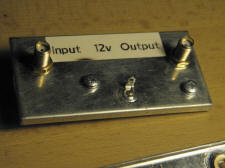 |
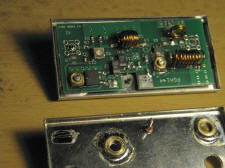 |
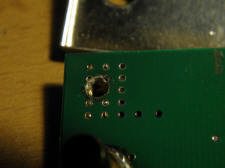 |
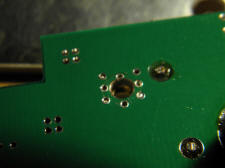 |
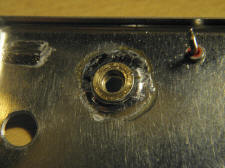 |
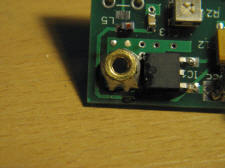 |
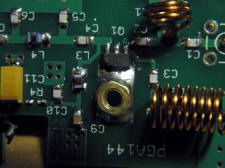 |
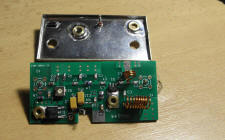 |
| Why the
LNA with the PGA-103 MMIC circuit fails?
Czech version above
LNAs
with this circuit have been quite popular in the world in recent
years. They have a good price-to-circuit ratio, plus the input and
output of the circuit is at low impedance and this simplifies use.
Still, in the race, radio amateurs will lose some LNAs with this
circuit. A closer examination usually confirms that the MMIC
amplifier is defective. Once upon a time, I lost a few words on this
topic in connection with the translation of the HB9AFO article,
later OK1VUM also dealt with this topic. To find out, perhaps only
that if the wire to the LNA on the mast at the antennas is tens to
hundreds of meters long, of course, the destruction of this circuit
by some induction peak cannot be ruled out. That is why integrated
voltage stabilizers are commonly used directly at the circuit, or
some varistors at the power input. Sometimes a parallel stabilizer
(LM431, zener diode and current source, etc.) is enough. If we
exclude gross defects (lightning strike somewhere nearby, a snagging
CINCH at the sequencer, insufficient insulation of the antenna
relay, or destruction of the LNA by crosstalk from the second
antenna, which was under power, while the antenna with the LNA was
switched to reception...) It would seem that there is no reason why
there should be problems with this amplifier. But they are. After
many years, we lost this LNA (and even two) again during the Marconi
memorial contest. These were preamplifiers built exactly according
to G4DDK's instructions, using his kits (kits) that my son bought a
few years ago. Since G4DDK's LNAs are very common and are considered
to be good designs, I was naturally interested in how the
destruction of the circuit could have occurred.
It wasn't anything unique, I'll leave the mysteries to others. The
destruction of the MMIC circuit is caused by the mechanical design
of the LNA from G4DDK, which has a printed circuit board closed in a
sheet metal box so that the mechanical and electrical contact with
the box has the ground surface of the printed circuit only in the
places of the input and output SMA connectors. This is related to
negligible heat dissipation from both the stabilizer and the RF
amplifier, which which are cooled by vias into the ground plane of
the printed circuit board. But the heat from it can no longer
continue, the box is not ventilated and so after a few hours the
temperature of the PGA 103 circuit case, on which the power loss is
about 500mW, rises above the value of around 85°C and the MMIC is
destroyed, which is of course helped by the heating of the internal
space of the LNA from the analog voltage stabilizer 7805.
That is why I created two thermal bridges in the G4DDK design - one
under PGA103 and the other under the stabilizer, which thermally
connect the ground plane of the LNA printed circuit board and the
metal box. Just look at the pictures. The brass ring, soldered to
the preamplifier cap, has a diameter of 6, an inner hole of 4 and a
height of 2mm.
OK1VPZ (11/2021) |
|







